Gotta try yet one more angle, in the renegade rules-ignoring department.
Of course it's the Shoshone. I downplayed them in the intro to that previous game. On normal maps, the Shoshone don't get all that much more frontloading than anyone else. They get fewer ruins because the expensive pathfinders take longer to build. The Shoshone get 100% optimal results, but any other civ can retry until it gets 80% of optimal on 125% as many ruins.
But the rigged renegade map is totally different, of course. I got 77 ruins in the Poland game. With no competing AIs, it doesn't matter if the pathfinders take a bit longer to deploy. And with numbers that big, the law of large numbers will catch up and regress to an average distribution of quality if you're not Shoshone. There's a vast array of wealth waiting out there for the choose-your-ruin ability, and I have to try it. I got 10 population ruins with Poland and was happy about that. The Shoshone with 77 total could make 26 of them be population, holy crap.
And I solved a few problems that the Shoshone would have:
One, building those pathfinders. In refining my Poland approach with a few practice starts, I was having trouble merely fitting in two extra scouts without pushing the build queue back enough that it would delay settlers. Poland needed 50 more hammers of scouts over a normal game; the Shoshone need 150 extra to build five pathfinders instead of three scouts. But El Dorado showed me the way: the answer is to simply buy them! Worker buys can wait. 220 gold / 45 hammers to buy a pathfinder is surprisingly decent value, only a little worse than a worker at 310 / 70. And if that pathfinder finds a single gold ruin, it nets out ahead. Workers can wait, buy pathfinders first.
Two, city-state tributes. I was keen on using a ruins-upgraded spearman for tributes, something the Shoshone can't do because they start with a pathfinder instead of a warrior, which upgrades to a comp-bow instead, which isn't strong enough. But the answer is to simply use two units. Keep two pathfinders near each other as they sweep around the inland sea, and a combined strength value of 16 is enough to tribute any city-state even on a hill.
Three, the social policy path. As I mentioned before, nobody but Poland can cover all of Liberty, Consulates, and Mercantilism. Something has to give way. I'll just have to do this without Patronage. Patronage is merely helpful but Mercantilism is mandatory; the endgame of buying schools and labs and spaceship parts just doesn't work without it. And Commerce works better because it can come later (after Rationalism) while Patronage needs to start early. Enable Policy Saving means the would-be Patronage policies can be saved and redirected into Rationalism instead. The sequence works perfectly: 5 policies into Liberty, then save the next 4 to crash-dump into Rationalism, then the next 3 go up to Mercantilism just when we need it to buy schools.
Game settings: Prince difficulty, Inland Sea map, huge size, max 41 city-states, minimum 1 AI opponent (Dutch), hot climate, young world age.
City-state rigging: got 10 maritimes and 12 mercantiles on my very first roll, and decided to just keep that. Where Poland favored maritimes, the Shoshone want to lean towards mercantiles. The Shoshone accelerate faster on food, with Great Expanse to claim food tiles and ruins/tribute gold to buy workers, so maritimes are a bit less important. But without Aristocracy I'll need the mercantiles for happy, and lacking Patronage I'll have fewer allied city-states but more in the friend range which is where mercantiles have their value.
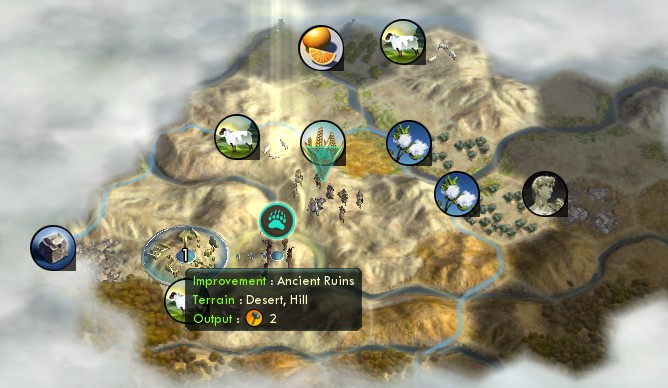
A prelude: I moved two turns to settle the capital, and actually got my first ruin before that. Can't take population before you have a city, so the next most important snowball factor is culture to get going towards Liberty.
Then I settled the capital, and holy unbelievable crap.
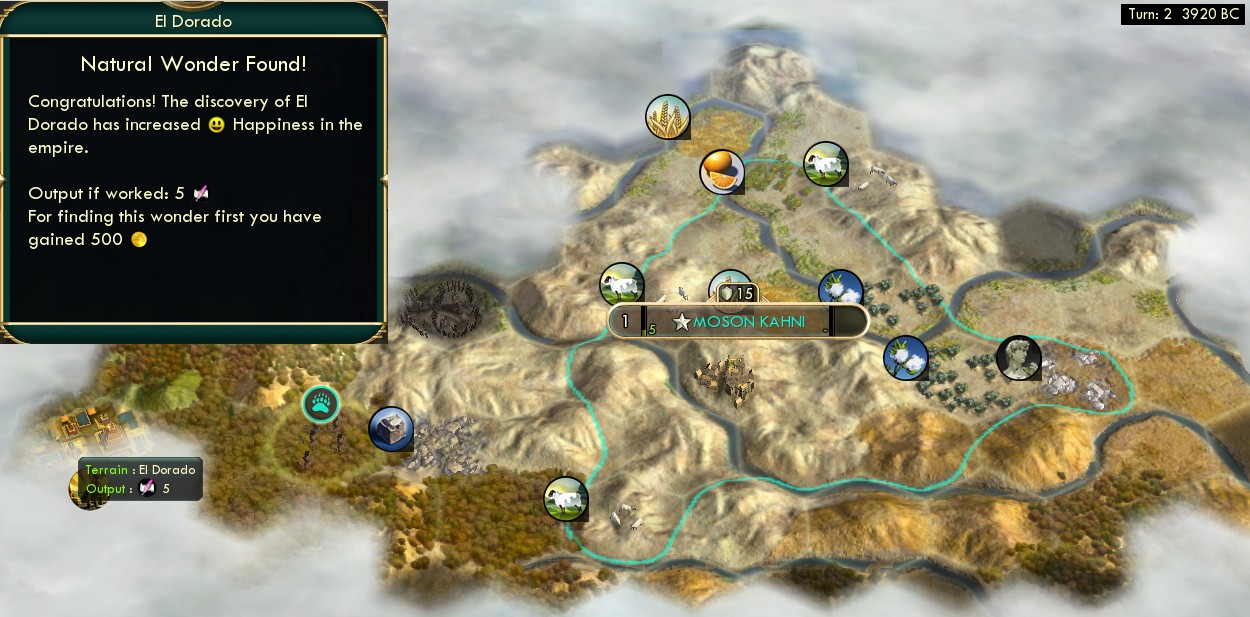
EL DORADO STRIKES AGAIN.
Alright, then. Let's see how fast this baby can gooooo.
I immediately bought two pathfinders as planned. And I had them by turn 3, ten turns sooner than last time. So now I could get more ruins faster than ever before. I continued to build three pathfinders in the capital, and also bought a third. The first six pathfinders dispersed to scour the inland sea as with Poland, and the last stayed to escort settlers.
I'm really not quite sure how best to convey how this went. I think this visualization works well, showing how the ruins basically operate on a three-stroke cycle. The game keeps track of your two most recent ruins rewards, and you can't duplicate the same one within that time, so on every third ruin is when you can choose the same result again.
| Turn numbers | Rewards | ||
|---|---|---|---|
| 1 - 5 | Culture for Liberty opener | Population to size 2 | 60 gold |
| 6 - 7 | Culture for Republic | Population to size 3 | 75 gold |
| 9 - 13 | Culture | Population to size 5 | 95 gold |
| 14 - 18 | Culture for Collective Rule | Population to size 6 | 70 gold |
| 18 - 20 | Culture | Population to size 7 | Faith for pantheon |
(Am I turning Civ into spreadsheets in space? Maybe. But I like doing that.)

And so it came to pass, on the absolutely insanely early date of turn 18, that the capital is at size 7 with Collective Rule acquired and ready to start the starvation settlers.
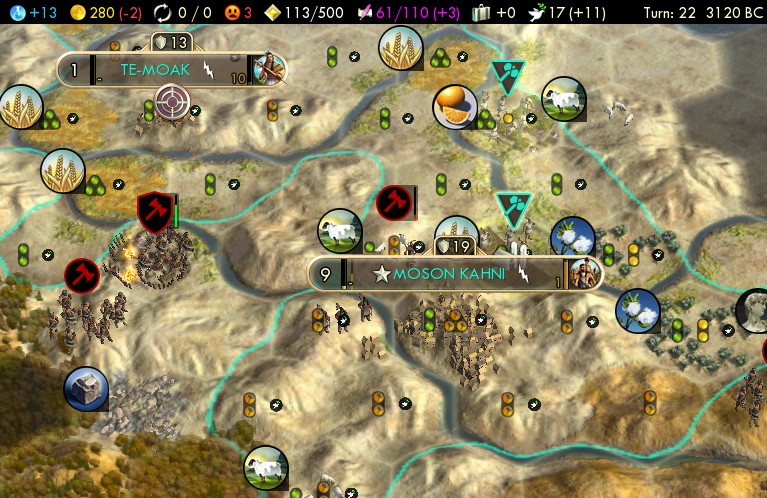
The Collective Rule settler itself went here, picking up a ton of wheat and also a hill for the capital to reach. (Notice the capital even grew two more sizes from ruins already.) Usually my second city builds the Pyramids from turn one, but this time I hadn't gotten to Masonry yet, and I needed to build a unit for escorting anyway.
But there's one problem going on, and here's the full disclosure. I already fell into unhappiness. There's no Mining luxury at the capital, which means we're unhappy already with just the second city. Which isn't a big deal except for this rule: population from ruins is disallowed while unhappy. And that's the whole point of this Shoshone game. I didn't realize how that situation would develop, that the second city would prevent population ruins, until I played as far as settling it.
I saw that the mistake was starting with Mining; the right approach was to go Pottery - Calendar first for the luxuries before Mining. And I reloaded back from the first turn in order to do that right. Typically after such a mistake, I'd abandon the map and start over, something that happens more than you ever know. But now any other attempt would leave me depressed for having wasted a perfect El Dorado map. I was actually away from the game for a couple days before replaying, long enough that I'd forgotten exactly where the ruins were, so didn't abuse that knowledge. I'm not proud of reloading, but I'm not competing for anything here and I get to do what I feel like.
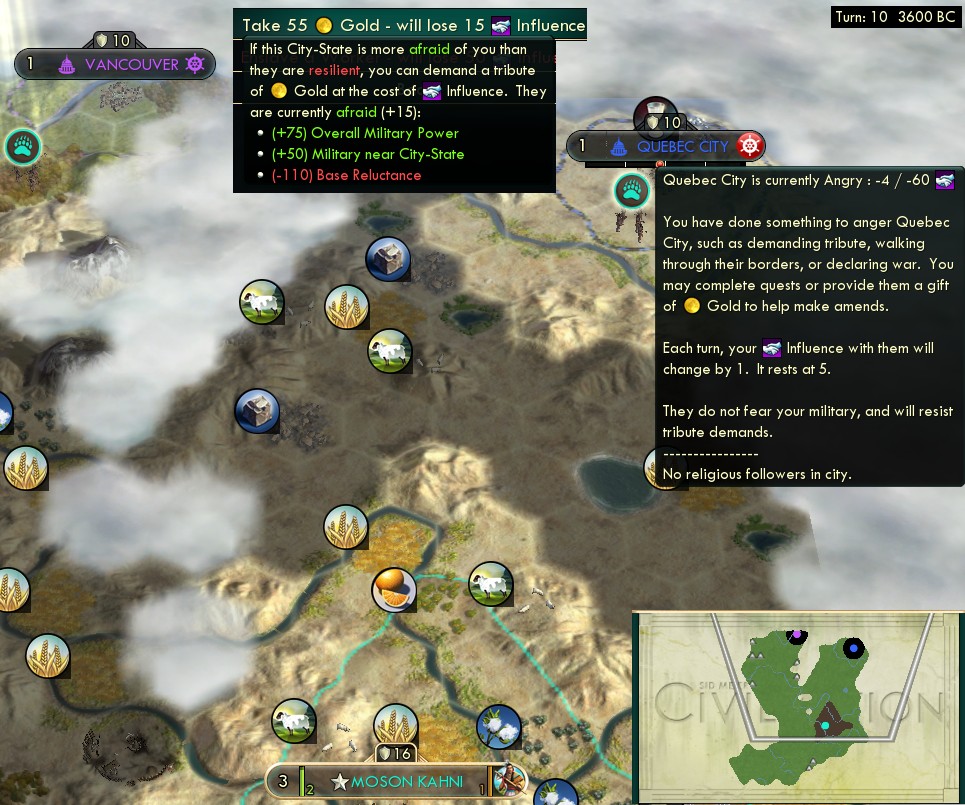
Back to the game. I was also enacting my other plan of tributing the city-states. Here are the first two. The previous turn, I had deduced Vancouver's location but not actually contacted it, so deliberately kept the eastern pathfinder exactly 8 steps from where I knew Vancouver's city center was.
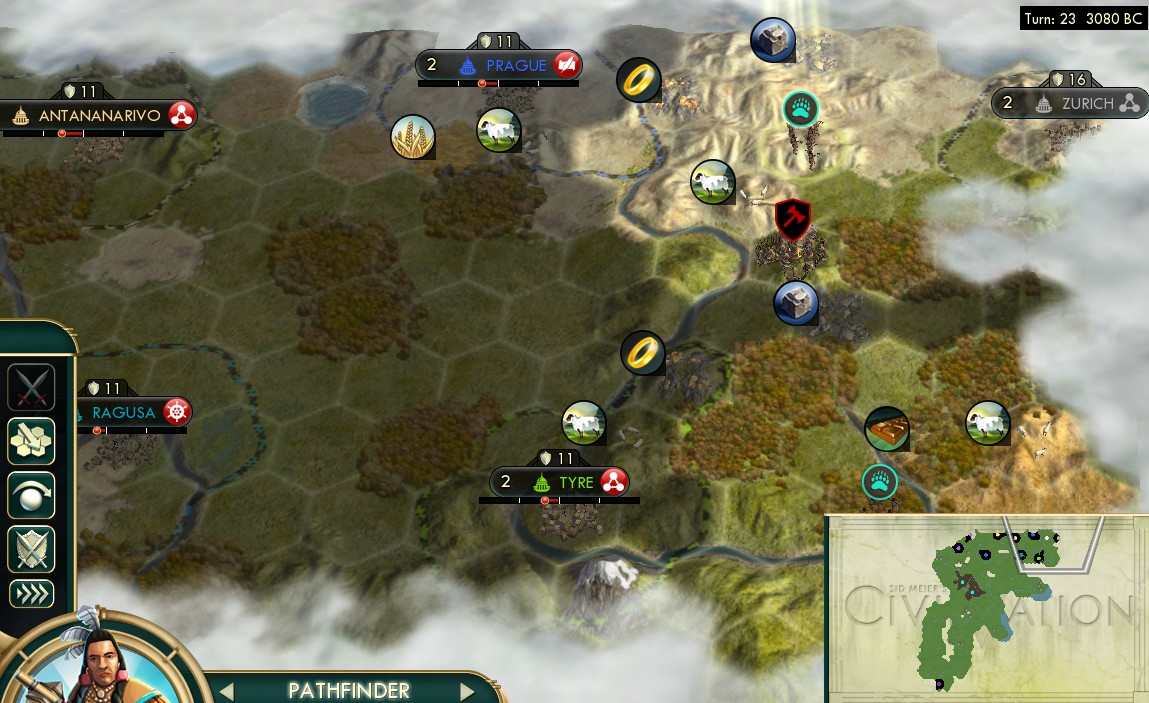
Here's a look at a few more, see all those angry city-states left in the wake of my two pathfinders. The mini-map also shows where another set of pathfinders are also reaching the southern front of city-states to open up tribute there too. It'll be tedious to show everything, so here's a summary:
- t10 tribute both Vancouver and Quebec City, buy third pathfinder
- t15 tribute Ragusa, buy first worker
- t16 tribute Kuala Lumpur
- t17 tribute Antananarivo
- t19 tribute Tyre, buy second worker
- t20 after ruin to pop 8, buy a hill
- t20 tribute Prague, buy a hill tile
- t22 tribute Sidon (the first one in the south), t23 buy third worker
- t28 tribute Cahokia, buy 4th worker
- t29 tribute Vancouver second time
- t30 buy a second hill
- t31 tribute Quebec City second time, buy 5th worker
- t33 tribute Wellington
- t34 tribute Yerevan
- t35 tribute Melbourne and Malacca, buy 6th worker a turn later at newest city
- t41 tribute Kathmandu
Back to ruins, in the same format:
| Turn 20 | Culture (6th) | Population to size 8 | 90 gold |
| 21 - 23 | Culture (7th) | Population to size 9 | 60 gold |
| 25 - 26 | Culture (8th) | Population to size 10 | 95 gold |
| 27 - 29 | Culture for Citizenship | Population to size 11 | Tech: Bronze Working |
| 29 - 32 | 90 gold | Population to size 12 | 60 faith |
I had decided that I would push culture from ruins at every opportunity until getting as far as Citizenship. That and Collective Rule are the important policies to frontload. Now culture wouldn't matter so much. I'd be taking only one more policy the entire way until Rationalism, which would be Meritocracy, and the timing of that didn't really matter. So leave aside culture for other rewards now. There was also one good spot to take a tech there, as I'd just finished researching something (Masonry). Finally, the last spot in this grid was a bad time to take a tech (one turn away from researching Animal Husbandry), and a good time to take faith when it would bring that total to just over 200.
| 32 - 37 | 95 gold | Population to size 13 | Tech: Sailing |
| 38 - 40 | 80 gold | Population to size 14 | Tech: Trapping |
| 41 - 44 | 65 gold | Population to size 15 | Tech: Writing |
| 46 - 48 | 65 gold | Population to size 16 |
As with Poland, I took care to expand my first few cities towards the corner of the map, so the capital would continue to be closest to and receive all the population ruins. That kept going for quite a while, with the capital rocketing all the way up to size 16! But presently that party came to an end. Four different limiting factors all converged at exactly the same time. One, now I'd filled the backyard and had to settle newer cities towards the center of the map closer to the ruins. Two, we were now unavoidably unhappy for several turns while improving luxuries in the outer cities. Three, just sustaining the capital at size 16 was becoming difficult -- it was running out of food tiles to work! And four, my pathfinders were now becoming more busy on clearing camps than finding ruins.
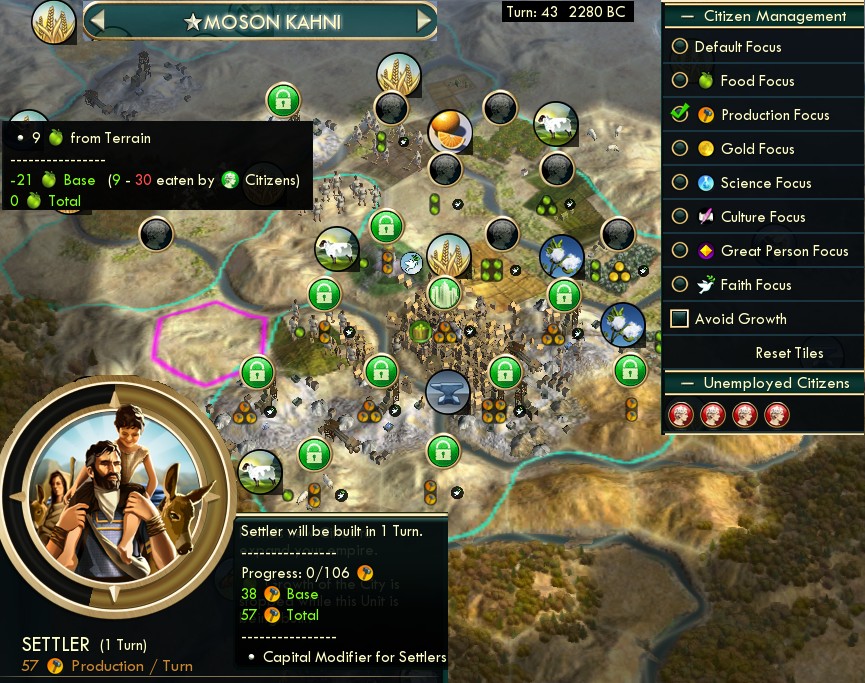
Here's the capital at the peak of its starvation settler powers. I'm completing this one in a SINGLE TURN with overflow from the previous settler. 57 hammers per turn as -21 food shortage vanishes into unaccountability. And that's with four unemployed citizens, with no more hills to work. This party also came to an end, as that was enough settlers (for 11 cities total) and there wouldn't be happiness to support more.
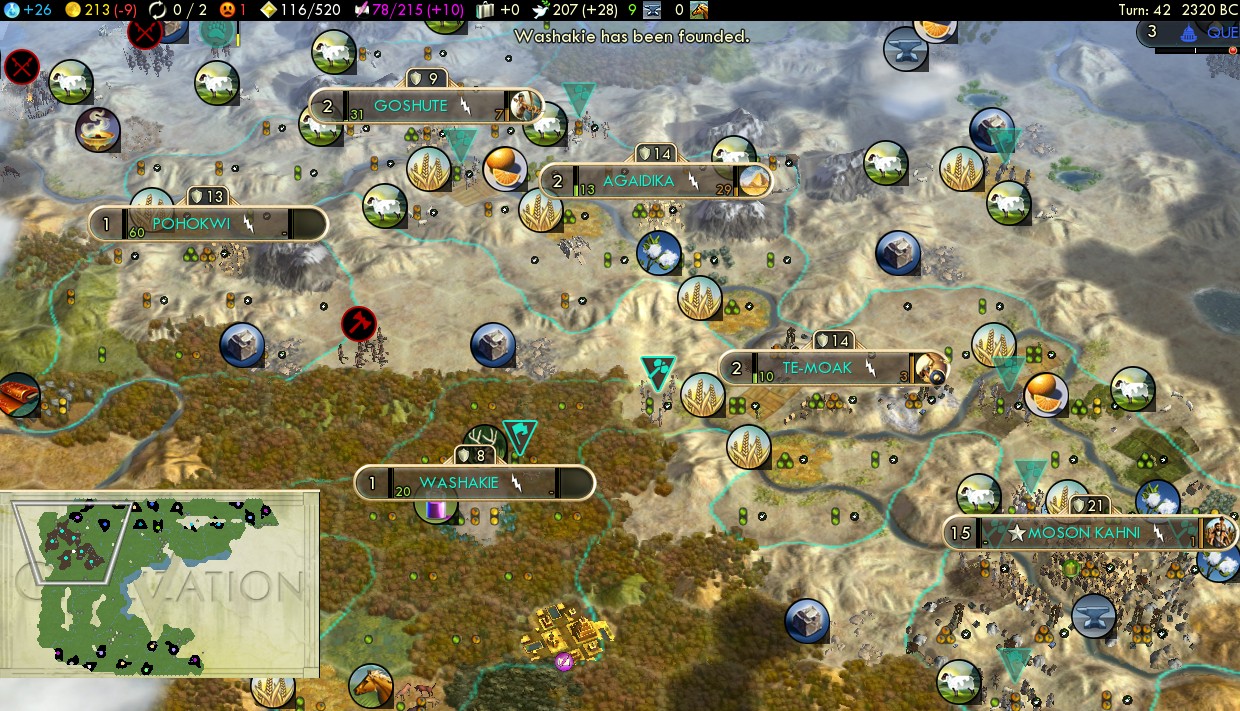
And here's a look at the developing core. The hardest part here was getting the luxuries hooked up quickly at each new city. Washakie had to be founded on the dyes to make that work, no time to wait 8 turns for a worker to get there and chop and improve it. Washakie's land makes for my most unexciting city in quite some time, but it does fill space well and can reach just enough food with that wheat and two of Te-Moak's flood plains. And it looks like I dropped into unhappiness here, but the dyes would immediately fulfill a quest for a mercantile city-state!
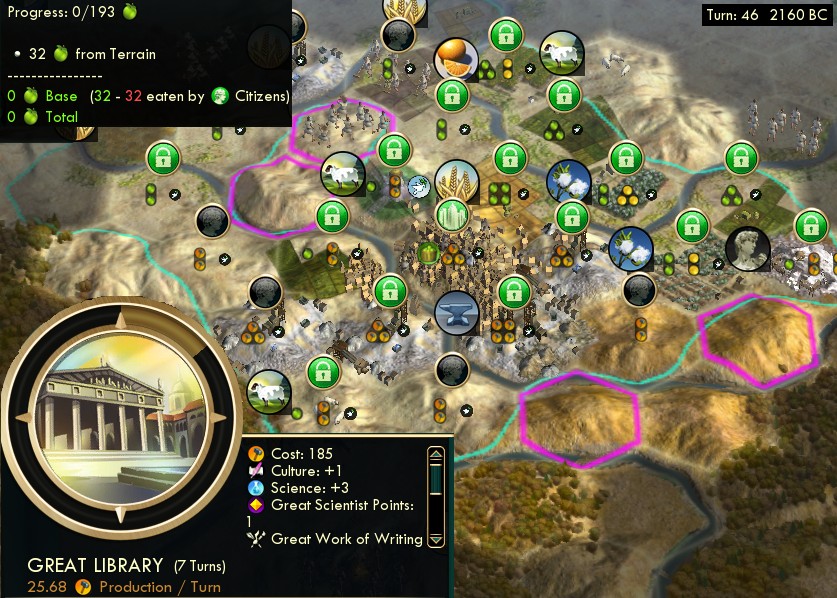
After the settlers, next I decided to just do the Great Library right now, before Petra. What's important with this enormous capital is to get the stuff that will be multiplicative with that city size. That means not the additive granary and watermill, which could wait. Better were to do the multiplicative items of the regular library (which the Great one covers) and Petra. The GL would only sling Drama and not all the way to Civil Service -- but actually I'd make up the difference in the cost of those techs by having the regular library operating for 20 turns before Petra rather than after. And doing the GL now would make sure not to lose it to a feisty AI competitor as Poland did.
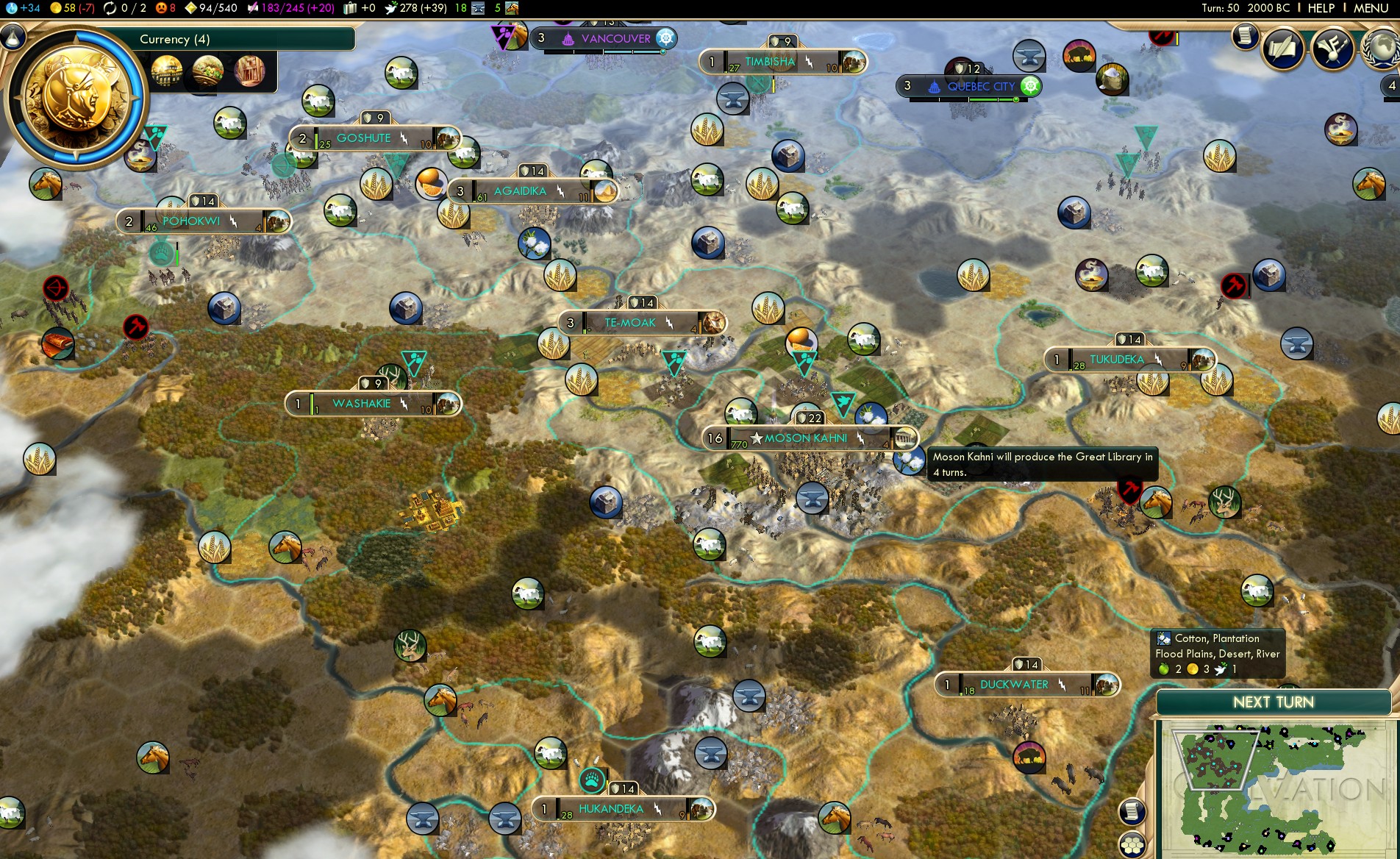
And here's the full core at turn 50 2000 BC. I've already produced all my settlers, the last one is up there in the northeast about to plant his city. I was skirting just on the edge of unhappiness during this. Three different times a population ruin dropped me from 0 to -1 happiness, but then I got a luxury improved or a mercantile friend just in time before the next ruin that would yield population. Presently that ran out and I crashed hard on happy for about ten turns until I could finally get the luxuries improved at those outer cities. I had enough luxuries (8 distinct types), but what was missing for happy was natural wonders -- I'd explored over half the map by now and found none besides El Dorado! OK, a Dorado map doesn't get to complain about natural wonders, hah.
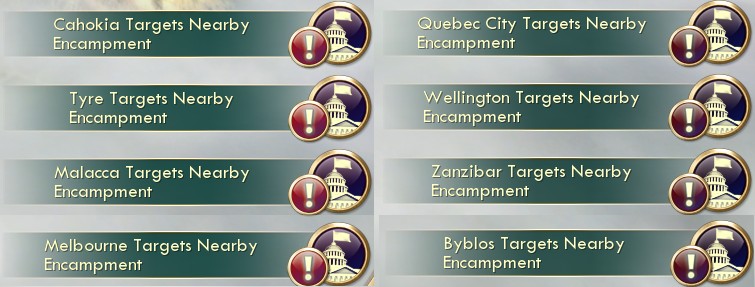
OK guys, I know, I'm trying to get to the camps!

Here's the first one, a short walk north from my core. I took the camp now, deliberately sacrificing that pathfinder to an attack by the second barbarian, but I judged it was worth it. It might take like ten turns to dodge that barb and heal and come back, and ten turns of maritime alliance is worth more than 45 hammers of one lost pathfinder. The worker belonged to Antwerp, making that a very useful mercantile ally (porcelain), and then I also judged it worthwhile to buy Vancouver up into alliance.

I sacrificed another pathfinder to get a four-for-one camp clear here, again deciding the turn value of the frontloaded alliances outweighed the cost of one lost unit.
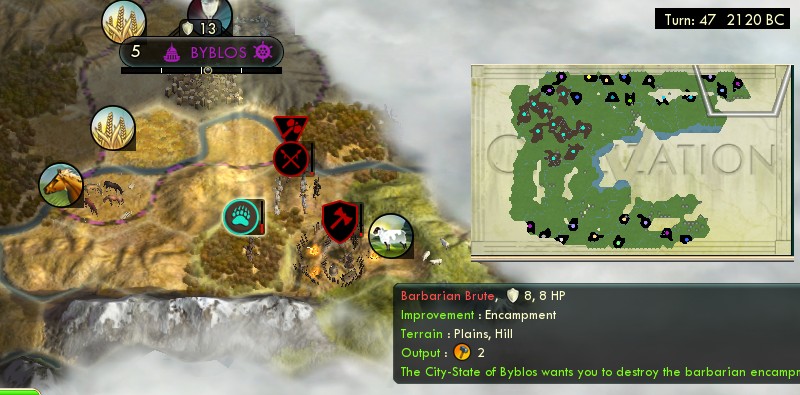
And here I smartly waited one turn until the worker came into the camp so I could clear both at once. That made Byblos my third maritime ally before turn 50, a blisteringly fast pace on that.

The luck I had in this game was how often I got highly overlapping camp quests. I had several three-for-one deals and at least two four-baggers. This didn't happen so much in the Poland game but did here. I'm not sure how typical this is for this map setup, whether this game got lucky or Poland got unlucky.
As usual, I'll leave off showing every one of the extensive list of camps I cleared. Here's a summary along with some other city-state events:
- Turn 54 returned worker to Quebec City for 3rd maritime ally (one other had worn off)
- t58 camp and worker for Ife
- t61 camp for Hanoi (first militaristic) and Zanzibar plus worker for Zanzibar, a huge turning point on happy
- t63 worker for Hanoi
- t66 camp for Wittenberg, Sidon, Budapest, Cahokia (and kept worker because it belonged to hostile militaristic Budapest)
- t66 worker for Tyre
- t67 camp for Ormus
- t69 camp for Prague, Zurich, Tyre, kept the worker because it belonged to Tyre (mercantile with duplicate resources)
- t70 camp for Panama City and Ur, worker for Cape Town, bought Ur into alliance
- t72 kept worker from Wittenberg, hostile religious
- t73 worker for Ragusa, 6 maritime allies
- t73 built Stonehenge to please Ragusa, Sidon, and Ormus (7 maritime allies)
- t74 that same worker for Cape Town a second time, 8 maritimes
- t77 camp for Genoa, worker for Mombasa
- t79 camp for Cape Town and Milan, workers for Cape Town and Panama City
- t80 camp for Malacca, worker for Hanoi
- t81 camp for Mombasa and Vilnius, worker for Mombasa
- t83 worker for Milan, third cultured ally (finally getting some of those)
- t83 camp for Melbourne, Yerevan, Wellington (9 maritimes), worker for Melbourne (9 mercantile friends)
- t86 camp for Jerusalem and Kyzyl, worker for Genoa (sacrificed another pathfinder for this one)
- t88 camp for La Venta, worker for Zurich
- t90 camp and worker for Bucharest, 3 cultured allies
- t91 great scientist quest refreshed Quebec City (8 maritimes)
- t94 missionary quests to Wellington (9 maritimes) and Yerevan (4 cultured)
- t103 camp for Buenos Aires, 4 cultured allies
- t103 camp and worker for Jerusalem, 2 religious allies
- t104 tribute Malacca for bullying quest for La Venta as third religious ally
- t105 two workers for Brussels, 5 cultured allies
- t111 tribute Antananarivo for bullying quest for Prague, 6 cultured allies
And one more important payoff from ruins.
| Turn 48 - 51 | 160 faith | 100 gold | Culture for Meritocracy |
| 52 - 64 | 160 faith | Population to 3 (not the capital) | Upgrade to comp bow |
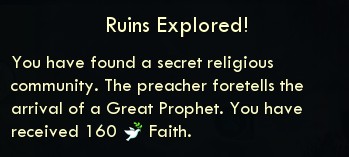
160 faith, twice. This was another trick I had my eye on for a while. I had settled the first prophet as usual, then spawned the second one. But I held on to that second one for a few turns. Once you found a religion, you can no longer get faith from ruins. But by holding off on that, I could get massive faith numbers from ruins in that interim. It turns out to always be 33% of the cost of the next prophet, rounded down to a multiple of 10. When the next prophet is 500, that comes to 160 faith from one ruin!
I got two such ruins, but couldn't go further than that because then the counter was at 500 and would have spawned that next prophet. But then I could found the religion and use that 500 faith already stored for the first missionary and pagoda right away (turn 52) and a second pagoda just a few turns later. (Later I realized I actually could have pushed this even further. Take and hold on to the 500-faith prophet [he'll be used to enhance], and the next prophet costs 800 so you should be able to pop 260 faith per ruin. But I was crunched on happy and needed to get the pagodas going anyway.)
Overall, religion went quite a bit more smoothly this time than in the Poland renegade game. (It usually goes smoothly, but Poland was an exception, with not enough desert.) What was missing from the Poland game but did happen here was one linchpin city converting at size 1 before growing. That's actually quite important. The first three cities (holy city plus the first two converted by missionary) project 18 pressure total, which isn't enough; that converts one citizen every 5.5 turns, but cities grow faster than that! Adding that fourth city worth of pressure to 24 total makes a big difference, now converting a citizen every 4.1 turns, and that is fast enough to keep up with growth. Finally I also got one more play right: I had to buy a second missionary to get everything converted, and the right way was to send that missionary to the outermost cities that wouldn't convert on their own, but would overlap their pressure back towards the second-ring cities. Anyway, overall I smoothly got the religion everywhere and bought all the pagodas quite quickly by about turn 90.
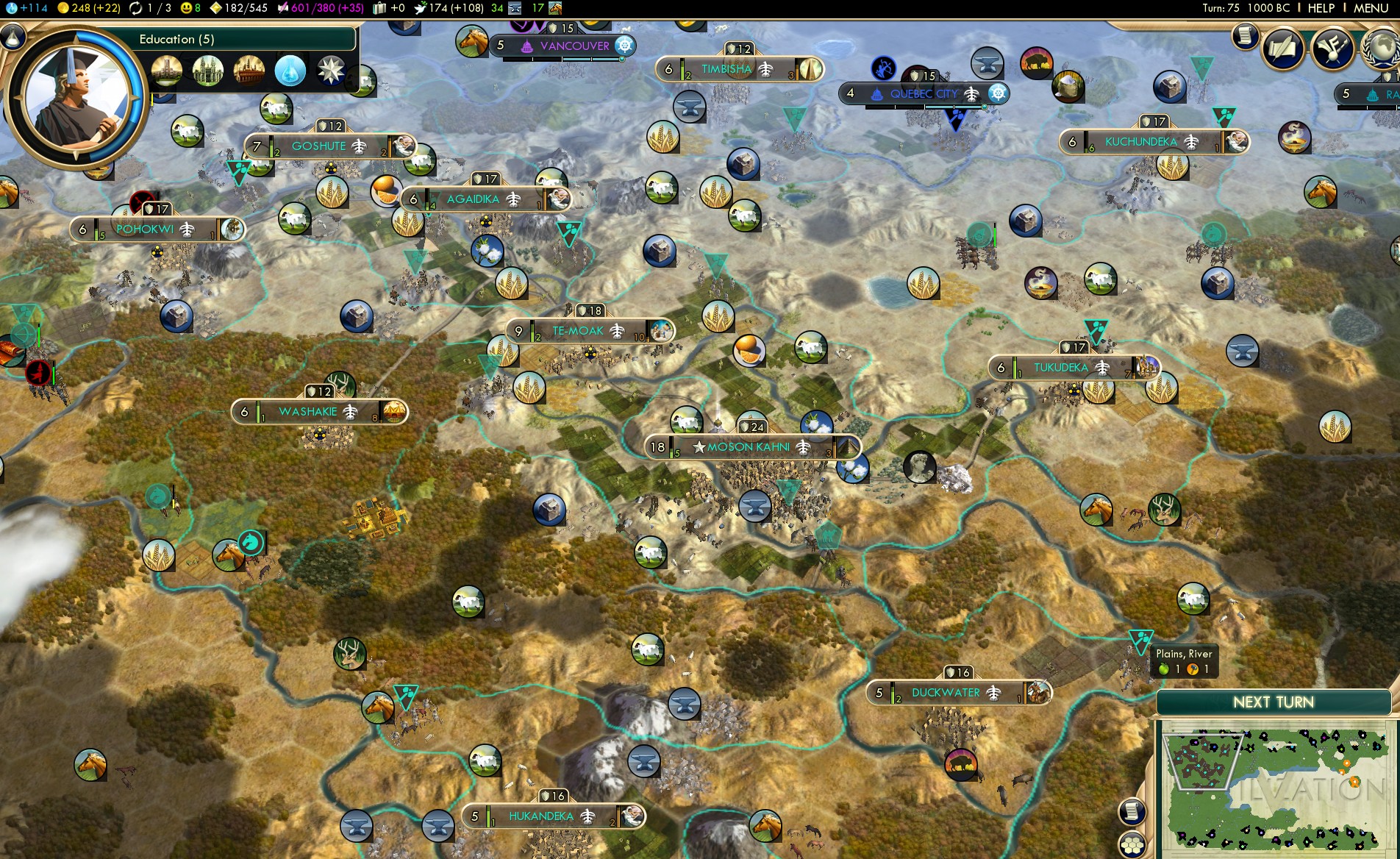
Back to domestic development. Here's the 1000 BC turn 75 overview. 80 population at this date is massively ahead of Poland's 60. 114 beakers to Poland's 84 is proportional as well.
I had built Petra at the scathingly early date of turn 60, and Education would arrive on turn 79! The massively ruins-boosted capital plus the Great Library got up to nine turns ahead of Poland. Of course the question was whether we could stay there. Nothing new would happen from here onwards to speed things up. Now that the Shoshone's frontloading was spent, and this civ lacked Poland's extra oomph of policies in Patronage and Tradition, this was just a race to stay ahead of my previous self.
Presently I used the capital's power to build WORKERS. I built four in a row after Petra. I wasn't exactly happy about this, didn't want to blow 280 hammers of the capital's build queue on items another city could have been doing. But that seemed like the most urgent need. We needed the road connections for Meritocracy, and for a brief moment the capital didn't have any other pressing priorities: Chichen Itza could wait until the happy GA was near, Oracle waits until the Renaissance, NC wasn't enabled yet, no Hanging Gardens when not in Tradition.
Thanks to these built workers plus all the early buys with the tribute money, I already had most worked tiles improved by this time, considerably ahead of Poland's pace. The Pyramids also helped a lot; that's a significantly underrated feature of Liberty as compared to Tradition. But ultimately, building those workers at the capital did end up pushing the NC back until after the university and Oracle. I'm not sure if that was a net loss on speed or not, though most probably it came out about the same either way.
The build order for most other cities went something like granary - horseman - library - university - aqueduct - garden - workshop. Monuments aren't necessary with Great Expanse, of course. Watermills ended up waiting a long time or even never in a few cities, stuck behind the other priorities. Every time I speed up the game clock, something does get squeezed out of the cities' build queues.

One thing that went well was buying luxuries from my one AI opponent. The Dutch turned up with three distinct luxes over time that I didn't have myself or from any city-states. (The Dutch allow you to take advantage of their civ ability to keep half the happy from trading away their last copy of a resource; they charge half what other AIs would for this.) These luxuries ultimately made up for lacking the happy from Aristocracy.

Religion: I did the usual sequence. Settle the first prophet (turn 35), found with the second prophet (t52), buy one missionary and some pagodas, enhance eventually (t69). That last was quite a bit faster than Poland, and Religious Community kicked in early to help build the granaries and libraries. Also I took Holy Order instead of Reliquary for once. I knew I had enough desert to reach 5000 endgame faith for three scientists but not 9000 for a fourth. Reliquary wasn't necessary, and I would have some spare faith to play around with missionaries. I would end up getting about six religion-spread quests to the city-states, a helpful addition that probably compensated about halfway for lacking Patronage.
Wrapping up the later game on ruins:
| Turns 80 - 83 | 100 gold | Population to size 9 | Upgrade horseman to knight |
| 83 - 85 | 50 gold | Population to size 9 | Barbs |
| 87 - 103 | 95 gold | Population to size 10 | Culture |
| 107 - 110 | 55 gold | Map | Culture |
| 110 - 116 | 100 gold | Upgrade horseman to knight | Population to size 16 |
| 118 - 127 | 80 gold | Map | Population to size 17 |
I hit a long drought on ruins, none between turns 65 to 80. All the pathfinders were busy fighting barb camps for quite a while, but eventually they got going again for a few more ruins, along with some units received from militaristic city-states. The ruins weren't quite so important now, now that population wasn't going to the capital and I was past the early frontloading of culture and gold and tech (had already finished the ancient age by turn 50). But still helpful. The later population ruins going to side cities started hitting some pretty massive numbers - the city closest to the center of the map grew to sizes 9, 10, 16, and 17 each from ruins.
It was amusing how constrained the menu of useful options became. Faith is no longer available once you have your religion. Population is unavailable when you're unhappy. Tech isn't available once the ancient age is completed. An upgrade isn't available if this unit already received one. So there were times when the menu was as thin as culture or map or barbs, hence those late culture picks.
From here, I'm going to tighten up the report and hit only the highlights. Everything now we've seen before. The Shoshone's frontloading is now complete, and the question is whether that will hold out ahead of Poland's later advantages.
Education came on turn 79, nine turns ahead of Poland. Acoustics on t88, and immediately put two saved policies plus the Oracle into Rationalism. I hadn't yet hit the next regular policy for Free Thought, which came 4 turns after opening Rationalism, but it took that long to finish building the universities anyway. Then research Engineering and build the aqueducts after the universities.
Around turn 103 I crashed hard on happiness for about six turns. I was trying to skip Notre Dame again, but no, you can't do that without Aristocracy. I had to have the capital go Leaning Tower - Notre Dame - Big Ben. That said, a happiness glitch of about five or six turns is survivable. What you do is stay at precisely 0 happiness. Let cities keep filling their food boxes, and set Avoid Growth in cities that do. Then when you do get happiness from somewhere, allow them to actually grow. This is how you "hide" growth from the game's happiness evaluation - keep it in the food box unspent into another citizen until you're ready.
To handle the happy crunch, I had to spend 250 gold twice to refresh mercantile city-state friendships, money that should have been saved into schools. But the major knock-on effect was delaying the happiness Golden Age a very long time. It didn't happen until turn 126, after Universal Suffrage fixed happy problems. Lacking that Golden Age also left me short on money, more in a bit.
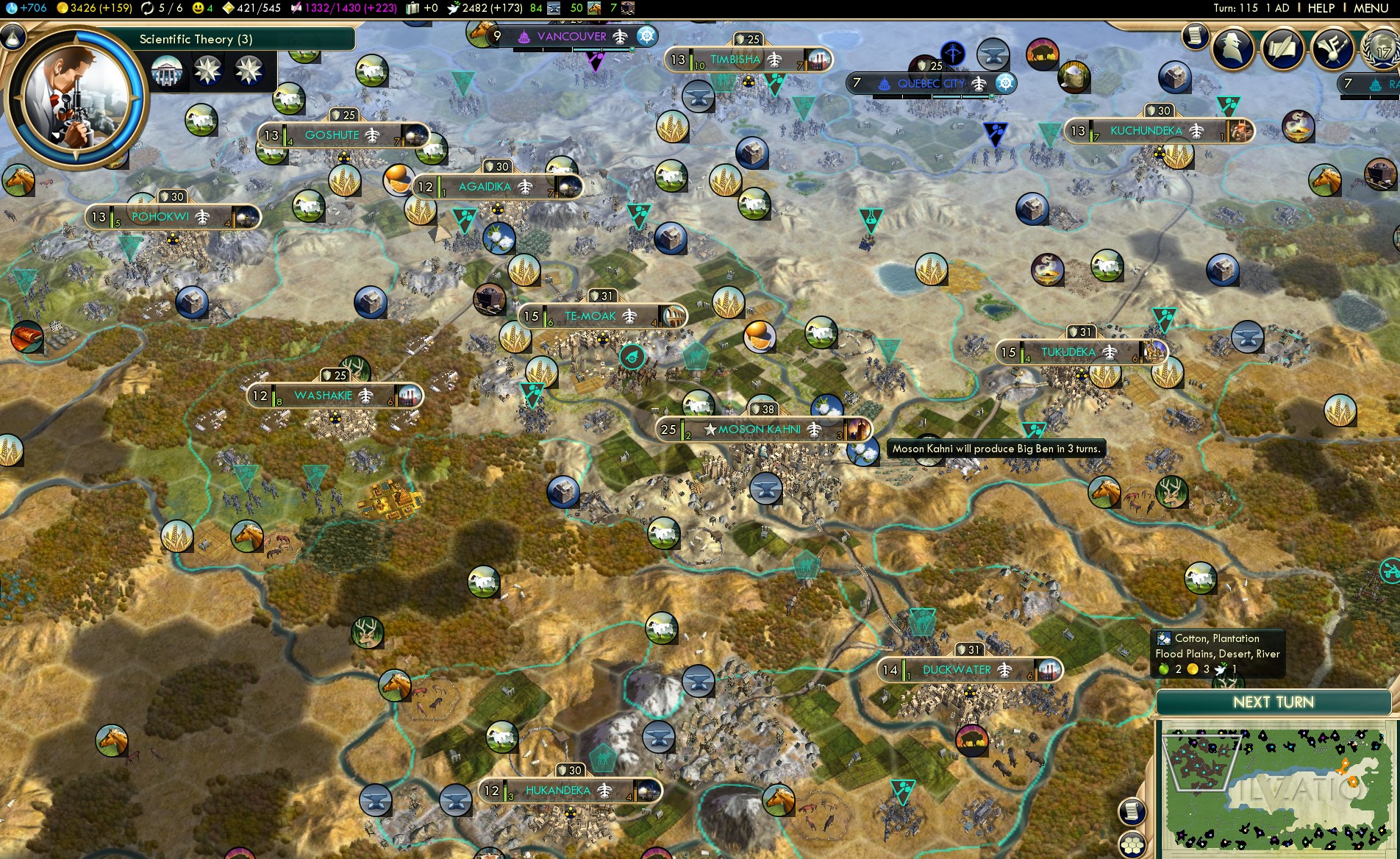
1 AD and here we are still setting records. 157 population and 706 beakers are each about 10% ahead of the Poland game. Scientific Theory is synched to come with Big Ben. I had now filled in the Commerce opener and Landsknechts, and the next policy due this turn would be for Mercantilism as planned.
I went to the industrial age in a slightly different order than usual. Directly to Industrialization, but then sidetracked to Astronomy before going to Sci Theory. I had five cities with mountains to build observatories, which would complete at the same time as buying schools (an observatory multiplies the beakers added by a school.) And I was short on money and needed those couple extra turns to save more towards schools anyway. And as usual I also had three cities building factories in parallel during the run-up to Sci Theory, to enable the ideology ASAP as well. It's hard to convey this in text, but I actually had quite an interesting and engaging puzzle trying to arrange all these build orders at the same time - the observatories, three factories, gardens, caravan slots becoming available, also the artists guild.
Turn 121 came the ideology, and I spent a great writer to get Universal Suffrage right away. Desperately needed as Notre Dame's happy had been consumed, and there was no room in the cities' build queues to get in any colosseums. Uni Suffrage always fixes happy problems for good in these games, particularly here when it finally reached the extremely belated happy Golden Age.
T127 bulb Steam Power, overflow to Rep Parts
T128 bulb Radio, overflow to Plastics. Still 9 turns ahead of Poland!
Except now one problem arose. I had money to buy only one research lab! I had been running 9 turns ahead of Poland in every area... except one: worker labor and time to build the trading posts. I'd afforded the schools only slightly behind schedule, but now was significantly late on the research labs.
I made up for it as well as I could. Kept building and working every available trading post, including at the capital (converting mined hills to trading posts; often the capital keeps its mines for the important wonders like Statue of Liberty and Hubble.) I actually had one city just build its own lab normally, invoking the usual argument that saving money for one marginal lab would come ten turns later or we could just build it in that time anyway. I couldn't fit the lab build into any more cities, though; they were busy with markets and caravans and the usual side-city late-game wonders of Oxford, Globe, Porcelain Tower, with one city doing a factory and hydro plant to gear up for Apollo.
Finishing up the policy schedule, which went completely by the standard plan: turn 134 Capitalism, t137 Statue of Liberty for Volunteer Army to go hunt city-state tributes, t143 the Rationalism finisher, t146 the second Great Writer for the Liberty finisher, t147 the third and fourth (via Globe) great writers together for Space Procurements.
And the endgame bulb sequence also as usual. I spawned up to the 800 GPP scientist normally, then added the endgame finishing scientists of Hubble, Porcelain Tower, three from faith, and the Liberty finisher.
- T138 bulb 12200 for Railroad, overflow to Flight and Ballistics
- T140 bulb 13300 for Electronics, overflow to Radar
- T141 bulb 13800 for Rocketry and Satellites, overflow to Atomic Theory
- T142 bulb 14300 for Nuclear Fission, overflow to Biology and Refrigeration
- T143 Rationalism finisher for Adv Ballistics (timing didn't quite work for the usual Satellites but that's okay)
- T144 bulb 14900 for Penicillin, overflow to Combustion
- T145 bulb 15100 for Ecology, overflow to Combined Arms
- T146 bulb 15300 for Telecommunications and again for Mobile Tactics, overflow to Computers
- T147 Hubble and Porcelain completed, bulb Robotics and Particle Physics, and Oxford for Nanotechnology.
So I finished the tech tree on t147 and should have won on t148. Except I still fell short on gold. I had only 7800 on hand, which went up to 9000 after selling the research labs. But that's still not quite enough; it takes 11000 to buy the entire spaceship with the usual discounts from Mercantilism and Big Ben. It would take one more turn of income and another round of selling buildings (schools) to buy the SS parts on t149 to win on turn 150. But I really wanted to crack that number, not just equal it.
But I had an answer. Notice in the list above that the three Hubble and Porcelain scientists accounted for only two techs. I actually overshot the tech tree by one entire scientist. This happened because the yield of each bulb was significantly about 1000 beakers higher than usual, once I had caught back up and eventually even overbuilt trading posts. I could make use of that...
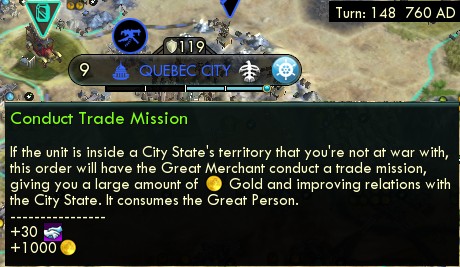
The answer was to use the Liberty finisher for a Great MERCHANT instead of a scientist! That was worth this 1000 gold and did indeed save that one coveted turn.
(How this actually played out: I calculated and anticipated all this before actually taking the Liberty finisher. I played it out anyway the usual way with a scientist just to see if I'd missed anything, but it went as expected. Then I reloaded from t146 to redo the Liberty finisher with the merchant instead. It also took some fancy tapdancing with workers building railroads to get that merchant over to the city-state in time.)

And so I can bring you a report that lacks the turn 150 overview screenshot, because it's consolidated into the victory screenshot at turn 149. So there's another 7 turns gained even over my Poland renegade game. Yes, the Shoshone frontloading on a huge empty map can indeed hold pace over everything else.